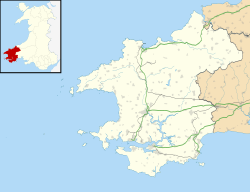| Little Haven | |
|---|---|
 | |
Location within Pembrokeshire | |
| Community | |
| Principal area | |
| Preserved county | |
| Country | Wales |
| Sovereign state | United Kingdom |
| Post town | Haverfordwest |
| Postcode district | SA62 |
| Dialling code | 01437 |
| Police | Dyfed-Powys |
| Fire | Mid and West Wales |
| Ambulance | Welsh |
| UK Parliament | |
| Senedd Cymru – Welsh Parliament | |
Little Haven (Welsh : Hafan Fach)[ citation needed ] is a village at the south-east corner of St Bride's Bay, Pembrokeshire, Wales. It is in the Pembrokeshire Coast National Park. Together with Broad Haven to the north, Little Haven forms The Havens community for which the 2001 census recorded a population of 1,328.
Contents

The Pembrokeshire Coast Path runs through the village. Since May 2012, this route has also formed a part of the Wales Coast Path. At low tide it is possible to walk north along the sandy shore from Little Haven via a larger bay known as the Settlands, past a second point ('The Rain') to the wider bay at Broad Haven. [1] There is an Anglican church in Little Haven.

